
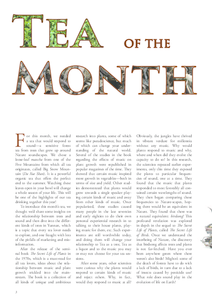 |
|
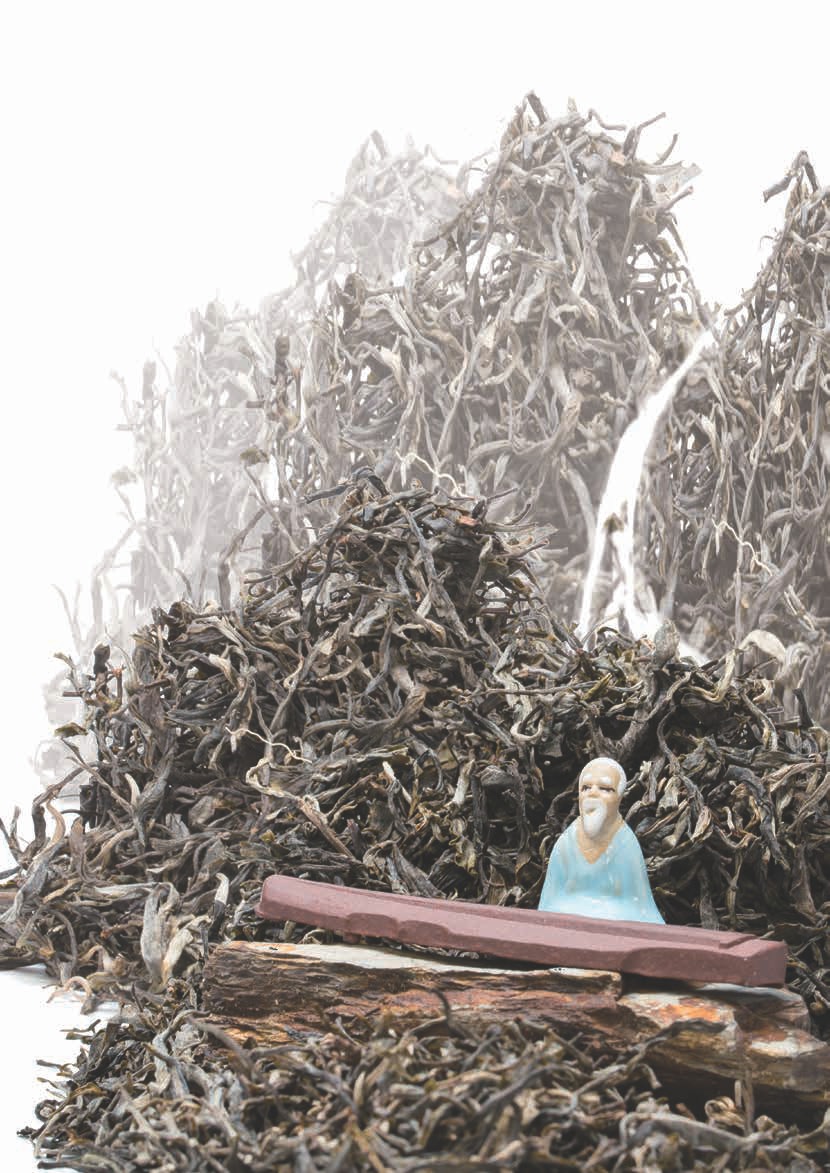
 | Forest Song (Sen Zhi Ga, 森之歌) |  | Big Snow Mt., Yunnan |  | 2016 Sheng Puerh Maocha |  | Wa Aboriginals |  | ~1800 Meters |
For this month, we needed a tea that would respond to sound - a sensitive forest tea from trees that grew up around Nature soundscapes. We chose a loose-leaf maocha from one of the Five Mountains from which all tea originates, called Big Snow Mountain (Da Xue Shan). It is a powerful organic tea that offers the perfect end to the summer. Watching these leaves open in your bowl will change a whole season of your life. This will be one of the highlights of our tea drinking together this year!
To introduce this month's tea, we thought we'd share some insights on the relationship between trees and sound and then dive into the different kinds of trees in Yunnan, which is a topic that every tea lover needs to explore, and one fraught with lots of the pitfalls of marketing and misinformation.
After the release of the seminal book The Secret Life of Plants in the 1970s, which is a must-read for all tea lovers, ideas about the relationship between music and plant growth trickled into the mainstream. The book is a collection of all kinds of unique and ambitious research into plants, some of which seems like pseudoscience, but much of which can change your understanding of the natural world. Several of the studies in the book regarding the effects of music on plant growth were republished in popular magazines of the time. They showed that certain music inspired more growth in vegetables - both in terms of size and yield. Other studies demonstrated that plants would grow towards a single speaker playing certain kinds of music and away from other kinds of music. Once popularized, these studies caused many people in the late seventies and early eighties to do their own personal experiential research in to talking to their house plants, playing music for them, etc. Such experiments are still worthwhile today, and doing them will change your relationship to Tea as a tree, Tea as a liquor and to the music you may or may not choose for your tea sessions.
After some years, other scientists were curious why the plants would respond to certain kinds of music and reject others. Why, in fact, would they respond to music at all? Obviously, the jungles have thrived in vibrant verdure for millennia without any music. Why would plants respond to music and why, where and when did they evolve the capacity to do so? In this research, the scientists repeated earlier experiments, only this time they exposed the plants to particular frequencies of sound, one at a time. They found that the music that plants responded to most favorably all contained certain wavelengths of sound. They then began comparing those frequencies to Nature-scapes, hoping there would be an equivalent in Nature. They found that there was a natural equivalent: birdsong! This profound revelation was explored in depth in the sequel to The Secret Life of Plants, called The Secret Life of Birds. Once we understand the interbeing of Nature, the discovery that birdsong affects trees and plants is not far-fetched. Have you ever been anywhere green where there weren't also birds? Mightn't some of the death of forests have to do with a lack of birds, in turn due to a lack of insects caused by pesticide use? What role does sound play in the evolution of life on Earth?
The details and facts of these studies aren't as important as the overarching theme, which is that all of Nature is connected, and in far more infinite and subtle ways than we could ever understand. One of the things that participants on our trip to Yunnan this year shared about was the amazing sound of the tea forests. Many said that even weeks later, after returning home, they were still able to close their eyes and hear all the birds, insects and other sounds as clear as day, since it made such an impression on them.
What does this have to do with our Tea of the Month? We know that we usually devote more of this section of each issue to the place and processing of the tea we are going to share, but since this issue is about sound and music, we thought it worthwhile to draw your attention to an often-neglected aspect of each month's tea, which is, of course, the sound that has gone into it. As people intrude and impinge upon the old tea forests, this subtle aspect of tea production will be unconsciously trod upon, and with a deaf ear. The fact remains that a lot of sound has gone into the tea we will all be sharing this month: birdsong, cicadas and a symphony of other insects, the wind and the trees themselves, as they flutter and groan
their songs to one another. And all of these vibrations are absorbed by the tea we drink. As we send this forest tea out around the world, we are also sharing these sounds, or at least their effects. These buds were born into that forest symphony, raised in it and, of course, educated in its language. There was a time when we understood that language and were fluent in its intricacies. Our ancestors had a much larger Nature-vocabulary than we ever will. But maybe a magical tea like this one will help inspire in us a desire to relearn some of the lost Nature sounds, starting with a deep appreciation for them.
The "song" of puerh isn't just the frequencies we can hear with our ears - the birdsong, cicadas, the wind rustling the leaves, and so on. There is a vast spectrum of sound beyond our psychosomatic constitution, beyond our capacity to hear. A dog would hear much more in the forest, and even what it heard would not span the entirety of sounds. Old tea trees in the forests of Yunnan are sponges for life. They are covered in molds, vines, and other symbiotic life forms - from those we can see down to the microscopic. In fact, one of the reasons the quality of puerh tea is so dependent upon the trees and their location is that the trees and leaves are covered in hundreds of species of bacteria and mold before picking, all of which encourage a unique fermentation in the tea. These microorganisms are also part of the song of puerh. Do they also have a sound? If our ears were stronger, would we hear them as a symphony as loud as the insects, wildlife and wind we are able to hear with our own ears? Does that sound also influence the tea leaves?
The "song" of any tea also includes the humans who process it, who are as natural to the tea trees as any other animal, especially when we live in balance. There are two main aspects of puerh production that make it unique. Different kinds of tea find their quality in different ratios between the terroir/tea trees and the processing skills of the farmers. For oolong, quality is at least half due to the processing and half the raw material (tea trees/ terroir). However, with puerh, like this month's tea, the quality is almost exclusively the terroir and the trees. There is little processing skill to speak of, mostly just simple preparation. This is changing, as local aboriginals focus more on puerh production and improve as a result. Again, the fermentation caused by the plentiful microbial life covering puerh is one of the reasons puerh tea is so special. This fermentation, more simply, is what really defines puerh tea, and the unique stages in its production act to facilitate fermentation. The first defining stage in puerh production is the de-enzyming, called "killgreen (sha qing)" because it literally kills a green enzyme in tea, which is done at a lower temperature for a shorter period of time than with most tea. This allows heat-resistant spores to survive the process, which will re-flourish the tea with a fauna of microbial life. The second unique stage is sun-drying, which activates these spores and therefore also encourages post-production fermentation.
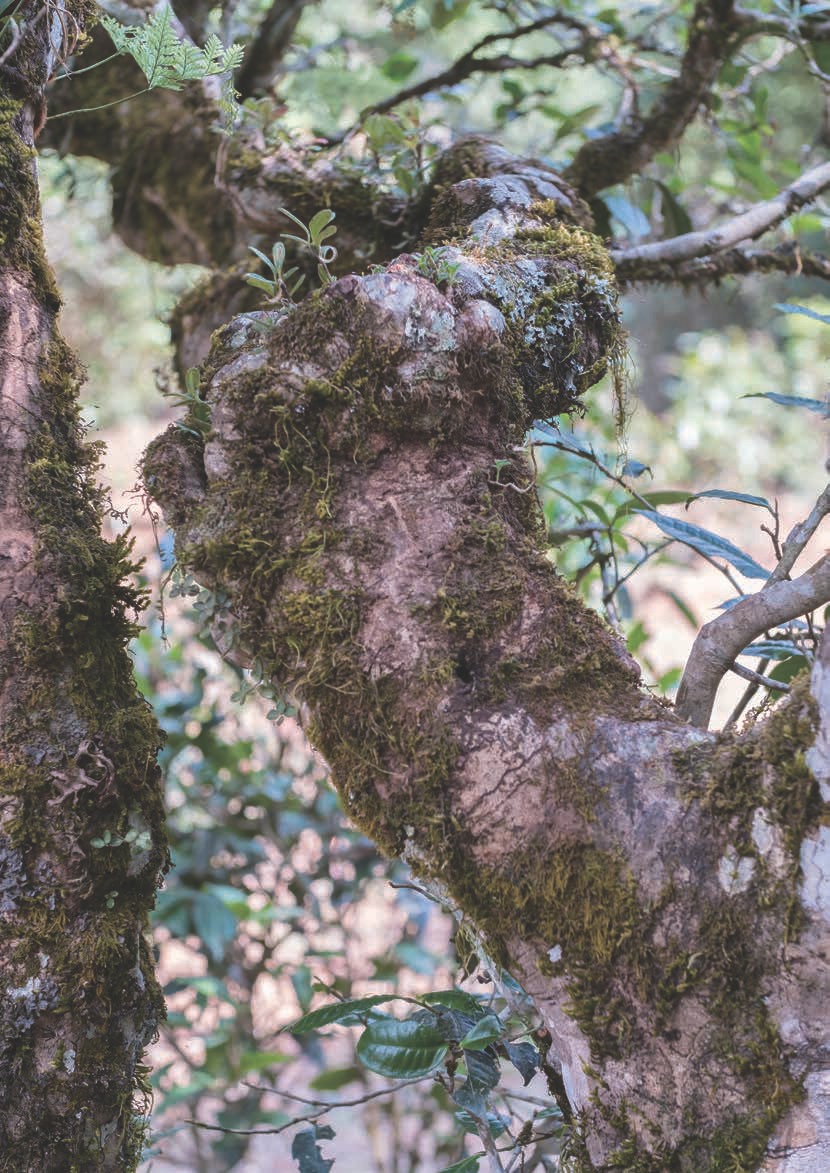
There is a lot of confusion surrounding the kinds of trees in Yunnan, and lacking common standards, understanding puerh tea trees can be difficult to navigate without standards. Different publications and vendors will have their own terms, categories and ways of explaining trees. Since the information is controlled by merchants, much of it is dishonest, which furthers the problem. The label "oldgrowth," for example, not only does not indicate any standardized age of tree, but it is often completely untrue. There are far more cakes labeled "old-growth" than there is genuine old-growth raw material in the world, and by several thousand times. At the Hut, we call tea "old-growth" when the trees are one hundred years old or more, and "ancient" when they get up near a thousand.
It is important to know that the size of the leaf does not help to determine whether the tea is old growth or not. Old trees still produce tiny, fresh buds, and small plantation trees also have large leaves. Tea trees in Yunnan are, after all, large-leaf varietals. This means that the trees are single-trunk with roots that grow downwards, unlike small-leaf varietals, which evolved as tea moved north (naturally or carried by man), and have several trunks with roots that grow outwards. Why the two categories are called "small-leaf " and "large-leaf ' is because the leaves that are allowed to grow to maturity on the trees will be very different in size. In other words, you can pick small buds from either, but if the leaves are left on the tree the large-leaf trees will produce much larger leaves, which can be bigger than a person's hand. The issue is complicated, however, by certain so-called "dancing" varietals of large-leaf tea in Yunnan that branch right above ground into several trunks. It is also complicated by the fact that some farmers pollard their large-leaf trees. Pollarding involves cutting the trunk so it produces more trunks and then, the idea is, more leaves. There is, however, some research that shows that this method doesn't really increase yield. Pollarding is obviously not the healthiest option for the trees. It is also done sometimes to make picking more convenient, but we would choose to refer to that as "pruning" to differentiate it from pollarding.
Another way to categorize large-leaf tea is to call it "chou mu," which means there is a single trunk that grows up about a meter before branching. Though there are varietals of large-leaf tea trees that branch lower down, there is still always a thick trunk, so the distinction can be useful. Small-leaf tea branches immediately, like a bush, with no visible trunk of any kind. (Again, the "dancing" varietals of large-leaf tea trees are an exception, though their trunks are still thick underground.)
To determine the age of a largeleaf, chou mu tea tree, you have to look at the thickness of the trunk, not the height. Tea can grow tall very fast. Even in ten years, a tree can be several meters tall. You determine the age by the thickness of the trunk. The girth of the trunk is also relative to the varietal, but in general, real old-growth trees have thick trunks. If the trunk has a diameter of two hands, you can be sure it is more than a hundred years old, and certainly old-growth. Over time, as you see more trees, you will get better at determining their ages based on appearance alone.
But every shop owner in China who sells puerh has photos on his or her phone of genuine old-growth trees that he or she is happy to tell you are the very trees that his or her tea is made from. Sometimes, they even hang signs with their logos on the trees for the photo. This is very rarely genuine, however. Sadly, there is an ocean of plantation tea and only a small stream of genuine oldgrowth tea. Learning to taste and feel the difference will be paramount in your tea journey; that and a good heart for Tea to find.
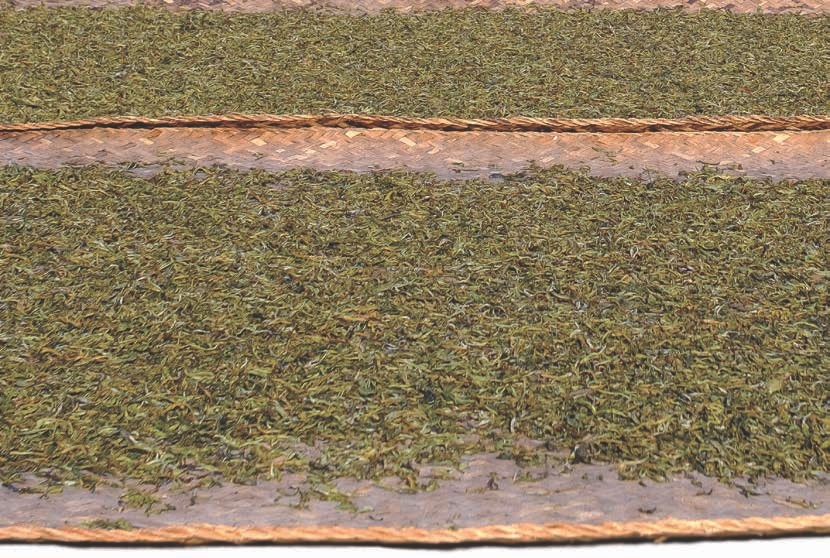
Maocha
The term "maocha" is used frequently throughout these pages. "Maocha" literally means "rough tea." Nowadays, it is most often used in discussions of puerh tea, but it actually refers to any unfinished tea produced at farm. With puerh, this means the loose-leaf sheng was sent to the producer/factory is finished in one of four ways: 1) packaged and then sold as blended/single-region looseleaf puerh; 2) compressed and sold as single-region sheng; 3) blended with other maocha, then compressed and sold as a sheng cake; or 4) piled to become shou, then compressed and sold as a shou cake. Traditionally, oolong tea was not roasted by farmers but by shop owners, who were master roasters, and therefore bought maocha from farmers and roasted it to their customers' tastes. This is all complicated by the fact that these days, many farmers will finish their tea themselves, whether by compressing and packaging it in the case of puerh or roasting and packaging in the case of oolong. Some even sell it themselves, and own shops in the cities.
After the distinction between small- and large-leaf, it is important to understand the three kinds of tea gardens in Yunnan. Again, there is no standardization in this, so we have had to create our own. Different authors and vendors will describe and label these kinds of gardens in their own ways, but once you have a basic understanding of these three, you will be able to navigate the discussion. We call the three kinds of tea gardens: "plantation," "eco-arboreal" and "forest."
Plantation tea is grown in rows, with tea trees propagated by cuttings planted close together, usually in lower-altitude, more accessible places, though plantation tea can be grown anywhere. The dangers of plantation tea are that this is where conventional farming is most predominant, which means the tea often is not organic and is grown industrially. As such, this tea is rarely as healthy for people and is most certainly worse for the environment. It also lacks sustainability. Such tea is not what we call "living tea." Living tea has six characteristics. It is seed-propagated, as opposed to tea planted from cuttings. The tea trees have room to grow - upwards to produce large crowns, and between each individual tree as well, allowing the plants to organize themselves. Living tea is grown in full biodiversity, surrounded by natural ecology. It is, of course, grown without the use of any agrochemicals (the Terrible Trio: pesticides, herbicides and/or chemical fertilizers). The relationship between the farmer and trees is one of respect and reverence. Within the character for "Tea" is the radical "human," as Tea is a relationship between Nature and human. Finally, no irrigation or fertilizer of any kind (even organic fertilizer) is used in living tea. This allows the trees to be independent, developing strong and deep roots connecting to the energy of the mountain.
The other issue with plantation tea as far as puerh goes is that it is missing much of what makes puerh tea unique. There is little by way of processing that distinguishes puerh (it undergoes a lower temperature/ lighter de-enzyming, sha qing, and sun-drying, both of which contribute to fermentation). Puerh is instead characterized by the rich biodiversity of the forests of Yunnan, the glacial water that flows there from the top of the world (the Tibetan Plateau, which extends into northern Yunnan), the old tea trees that live longer and have deeper roots than almost all tea trees, changing the medicinal qualities of the tea there, and, of course, the rich aboriginal cultural and spiritual heritage surrounding puerh tea. But all of these factors are absent in plantation tea, which is produced from smaller, younger trees that are rarely growing in the forest, etc.
The second kind of garden, which we call "eco-arboreal," is composed of living tea planted or growing wild near the edge of the village. These trees grow up in biodiversity and live in a healthy environment, but not in the forest. These trees are just outside the village and sometimes surrounded by other agriculture. These trees are more convenient to care for and harvest since the farmers do not have to hike to get to them. They are still quite happy and healthy, and as of now small Yunnanese villages aren't so bad to live just outside of, as many are still clean and in healthy balance with the environment. Not all eco-arboreal tea is clean, though. There is rarely ever any pesticide use with such tea, but some farmers do use weed-killers and/or chemical fertilizers to increase yield. In areas where these trees are surrounded by other crops, they can also be cross-contaminated if local farmers are using agrochemicals on those plants.
The final kind of garden is a forest garden. These can be wild or planted by people. These are gardens in the forest, often protected parks. The tea grows naturally in a full and flourishing ecosystem. Obviously, this represents the best of what puerh tea has to offer. Sadly, almost every puerh vendor in the world gives the impression that all of his or her tea is of this variety, when very little of this kind of tea actually exists anymore. Many times, you could hike into the forest and pass right by such a garden if you didn't know what to look for, since the tea garden would look just like all the other jungle you had passed by on the way there. These natural, forest gardens are what, as the old saying goes, "bring Nature to society."
Getting to know these kinds of tea and learning how to tell if the tea is really old-growth and what kind of garden it comes from is helpful, but also remember that in this tradition, we have a saying: "As the person seeks the Leaf, the Leaf seeks the person." What kind of tea finds us will have to do with our approach to Tea, our relationship to the Leaf and how we serve it to others as well. Our heart will guide us to the right teas, just as the right teas will find the people with heart. When you respect Tea as medicine, and are committed to protecting the aboriginal culture and environment in which old-growth forest tea grows, such tea will find you.
Forest Song is an amazing sheng puerh. It comes from eco-arboreal gardens, which are a great compromise to the world's need for more tea. The energy of the Big Snow Mountain region itself is amazing, with jungle forests and great snowy peaks above. The openness of these mountains is in the tea. When you drink it, you will understand. It has a very open quality. These days, it is tricky finding clean living tea in Yunnan since some dishonest farmers will switch the tea. However, this tea comes from a very reliable source. If that wasn't enough, though, we had the tea lab-tested just to be sure and it came back as chemical-free.
The tea from Big Snow Mountain is always very smooth and pleasant to drink, even when it is young. The energy is pure and bright. This was one of the best maocha (rough tea) that we tasted this year and was at the top of our list of choices for Light Meets Life cakes, but we had already spent this year's budget for sheng on teas from places we visited on our trip to Jingmai and Ai Lao Mountain. This tea was hand-picked and processed by the Wa aboriginal tribe.
The Lincang region is the northernmost of the three major tea areas in Yunnan. It is also the birthplace of all tea. The forests there have the oldest trees, and deepest roots in Cha Dao. There is some disagreement amongst scholars as to the origin of tea, but in traveling to the three major areas of Yunnan, we have found that the Lincang region is the home of all tea. We especially feel this in the "Five Mountains." Our understanding, however, is based more on a feeling, a connection and affinity to Tea and Her spirit than on any linear proof - take it or leave it... The five mountains from which all tea originated are Ming Feng (鳴風), Mang Fei (忙肺), Mei Zi Qing (梅子菁), Wu Jia Zhai (武家寨) and the home of our Tea of the Month, Da Xue Shan (大雪山).
We find the liquor of this month's tea ethereal beyond description. The color is perfectly white and golden, shining brightly in any light. It is both light and deep, uplifting and centering. It is crisp and clean and tastes like wind, but it has the strength of young puerh as well, which means it will go the distance. It is cleansing, purifying you like a late summer breeze that breaks a heat spell and calms the soul. We find it both calming and invigorating throughout a session. It is yin, but in a very balanced way.

The conductor taps the bowls together: Hush... Lid clinking, tinkling shards Pouring, slushing Drip, drip, drip Plunk, spin, plunk, spin Slurp and ahhhhhh!
Forest Symphony Conducted by None And sung by the thousand-voiced Naught To the accompaniment of stringless melodies; Resounding hollow beats Pound through vast meadows of vacuity. Ending in a crescendo of silence, The invisible audience cheers And raises empty bowls. Is the song heard when none are there?
We sat deep in the forest, A circle encircled by trees, One and all inspired by the song: Slurp, slurp, slurp.

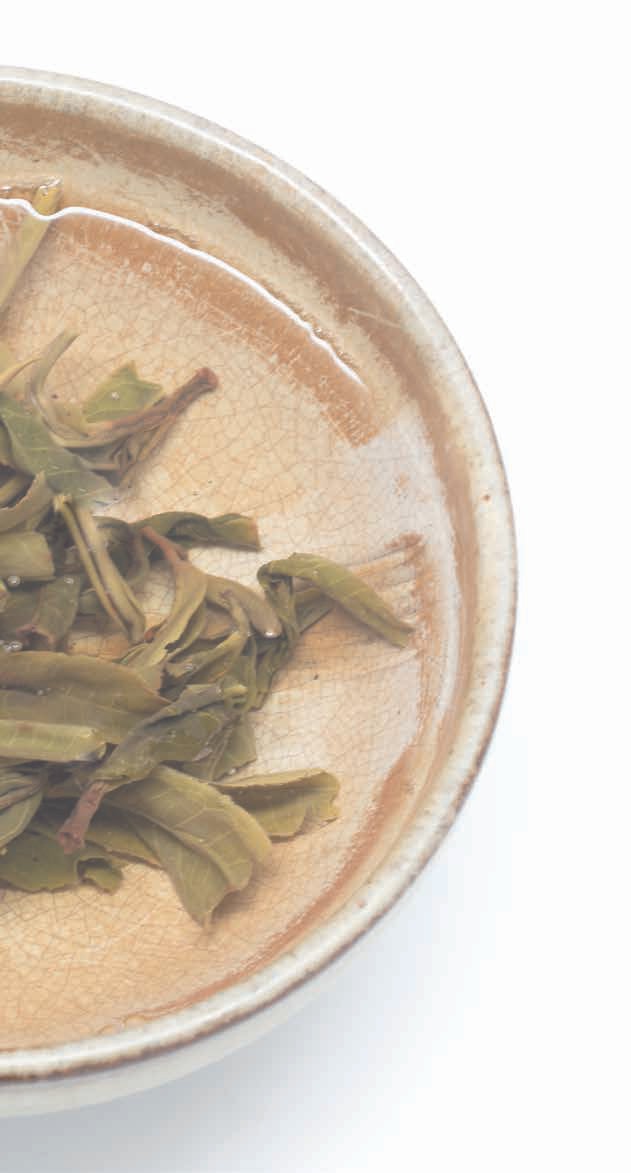
There is no better way to end the summer than with some young sheng maocha directly in a bowl. In this way, you can also share this tea with many of your friends and loved ones, with just a few leaves in each bowl. Watching such beautiful green leaves open is one of the greatest joys of the tea lover.
As this is an issue on the relationship between sound and tea, we recommend brewing this tea outdoors in the park or indoors with music. Try to notice the sounds of the forest or music without labeling or evaluating. Just let the vibrations of the sound pass through you. Pay attention to the tea and see if you can feel how the tea is also changed by the sounds. If you drink the tea in silence, see if you can - somewhere deep down - hear the forest sounds from where the tea came.
Of course, with such a tea as this, water will be of the utmost importance. Choosing nice spring water is essential to bringing out the best in a tea like this, even if it is purchased in a bottle. Be sure to use the best water you can find. Such a gentle sheng tea needs a fine water without flavor, full of minerals and smooth to bring out the best the tea has to offer you.
The energy of the water while it is boiling is also very sensitive to sound and you can practice becoming attuned to this even with just water. Try boiling one kettle in silence and then one with music and see what the difference is. The water will absorb the energy of the music and be changed by it. Hopefully, you will be able to notice this, as with the tea. This will help you know if and when to use music in your tea sessions and what kind of music to select when you choose to do so.
As the water is boiling, it is at its most sensitive, which is why the job of cha tong (water-bearer) is so important. At the time of boiling, as the water is finding its structure, it needs a calm presence tending it - with gentle, graceful movements and a kind yet peaceful, heart. In this way, the water is filled with positive energy while simultaneously left as undisturbed as possible as it finds its way to a sound and smooth structure.